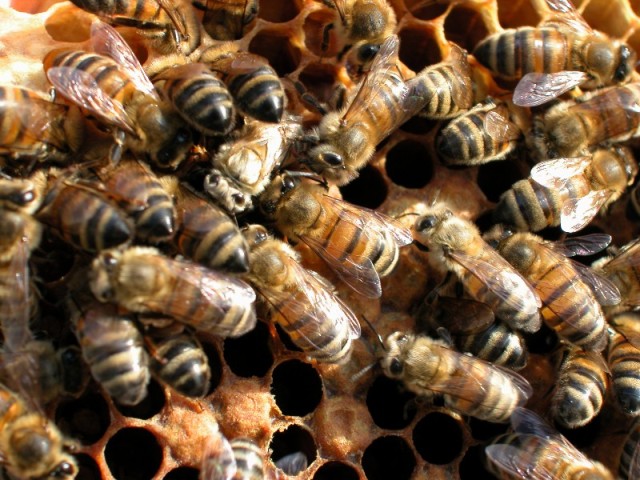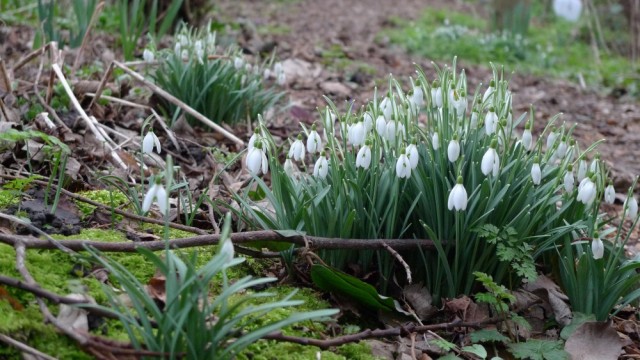- I did a couple of FAQ blog posts, here I have collated them together…
Q: How do prolonged periods of rain affect bees?
A: Long periods of rain in the summer may prevent bees being able to forage and virgin queens being able to make mating flights. On the up-side, flowers rely on rain to be able to produce nectar.
Q: What are the best things we can do to support the bee population?
A: Plant bee-friendly flowers in your garden. Bees are colour-blind to red, so red flowers are unlikely to be appreciated (unless they appear ultra-violet, which bees do see, e.g. poppies). Blue and purple flowers tend to be popular – lavender, borage, heather. Herbs are also well-visited and have the bonus of being sweet smelling and good for your cooking, e.g. rosemary, marjoram, mints, chives, thyme. If you have a tiny garden or even just a windowsill, herbs are ideal for growing in pots.
The flowers chosen should be planted in clumps by type, not singly or in twos, and in a sunny spot of the garden as much as possible. Bees often overlook flowers growing in shade, even though they produce nectar and pollen.
Planting early flowers – snowdrops, crocuses – which help get colonies going in the spring, is helpful. However, research by Professor Ratnieks, Professor of Apiculture at Sussex University, has found that the average distance foraged by honey bee colonies he studied in March was 1/2 kilometre. In July, this increased to 2km. This suggests that in spring, bees find it relatively easy to find flowers, whereas in late summer and autumn they have to go further.
So despite the warm weather of summer, in terms of planting available forage it is in summer time that bees really need our help, more so than in winter or early spring. Many beekeepers remove honey supers from bees in August, just as the amount of available forage drops. Good late-summer plants include lavender, borage, majorams, sedums, greater knapweed, phacelia, buddleia, heathers, ivy, Michelmas daisies – these will provide a final boost to honey stores.
If you are really lucky and have enough space to plant trees in your garden, lime trees are a major source of forage for bees here in London and make fabulous honey.
The British Beekeepers Association (BBKA) has some useful leaflets on planting for bees freely available on its website:
Bumblebee expert Professor Dave Goulson has a pretty A-Z page full of photos and explanations of the best garden flowers for bees, from Allium to Wisteria:
The Royal Horticultural Society has some smaller-scale flower lists:
To buy wildflower and other bee-friendly plant seeds, visit beehappyplants.co.uk.
Bees also need a place to drink from and collect water to cool the hive on a hot day. A pond, bird bath or shallow source of water with pebbles in to prevent the bees drowning will be appreciated.
Finally, why not support your local beekeeper and buy honey straight from the producer? Amateur honeys can be superior to those in supermarkets which tend to be blended together using honey from multiple hives or even countries, obscuring the delicate individual taste of each original honey.
In Ealing local beekeepers sell their honey at the apiary on the junction of Stockdove Way and Argyle Road, in Perivale between 2-5pm most Saturdays of the year (depending on what’s on that day and the weather, though we have been known to sit out in the snow!) . Visiting directions here.
Q. What happens to all the bees in winter?
Honey bees live longer during the winter; worker bees flying all over the place in the summer live around six weeks compared to several months in the winter. The queen and a reduced colony of around 10,000 workers will over-winter together, the workers huddling in a tight ball around the queen and vibrating their muscles to stay warm. They feed on their honey stores and leave the hive only for cleansing (pooing) flights. The beekeeper opens the hive only to administer anti-varroa treatments or feed candy.
Bumblebee colonies do not over-winter; only the queen hibernates and starts a new colony in the spring. Worker bumblebees die out in the autumn.
Q: Why do I now see many huge bees in the garden and few ‘normal’ size ones?
A: By ‘huge’ bees, this commenter probably means the big furry bumblebees, and by ‘normal’ they mean honeybees or even solitary bees. Many wild colonies of honeybees are believed to have died out in the UK due to the pressure of living with the recently introduced varroa mite. It is also possible that the larger, slower flying bumblebees with their black banded fur are more noticeable than the nippy honeybees.
Q: Is every bee different in appearance and is it possible to determine certain characters when working with them like you do?
A:All honey-bees in a colony are at least half-sisters. However, a queen bee mates with multiple drones, so they may have several different fathers. Although worker bees tend to look very similar there can therefore be colour variations from ginger to light brown within a hive. Is it possible to determine certain characters? Among 50,000 pretty identical worker bees? No way! Colonies as a whole do have a ‘hive personality’ or mood though, and particular colonies soon get a reputation on the apiary if they are especially mardy.

Honey bees – they can tell themselves apart, we struggle. Courtesy The Food and Environment Research Agency (Fera), Crown Copyright
Q: Could we pollinate flowers without bees/wasps?
A: Yes, and some poor farmers in China’s Sichuan province are having to do just that for their pear trees since over-use of pesticides caused the local bees there to die out. Surprisingly enough, a person climbing up on a ladder with a feather brush does not rival a bee for efficiency of pollination.
Q: What kind of relationship do bees in a hive have with each other? and how do they have rules?
An interesting question this. Each worker bee works together to fulfil the colony’s aim of raising brood, producing sufficient honey stores for the winter and, if the colony is strong enough, reproducing by swarming. After spring/summer worker bees are born they progress through various ‘work experience’ roles – cleaning out cells, nursing larvae, producing wax, taking nectar and pollen from foragers, guarding the hive, removing dead bees etc, until they are old enough (around day 20) to reach the final top job of foraging.
Drones have their place in the colony too, as sperm donors for virgin queens, and are fed by the worker bees until their usefulness runs out in the Autumn. Last but not least, the Queen is the colony’s egg laying machine. She can lay around 2,000 eggs a day – more than her own body weight!
How do they have rules? The answer is quite complicated as bees communicate in multiple ways. Probably the most important is smell. For instance, the queen produces a pheromone smell beekeepers call ‘queen substance’. As bees take it in turn to clean and feed the queen, queen substance is distributed through the hive. Its smell reassures the bees and also prevents worker bees from laying eggs. The colony will notice a missing queen within half an hour of her disappearing, and the beekeeper will notice that a queenless colony is particularly irritable. Different pheromones are also released by brood to let the nurse bees know when their cells need sealing, and by worker bees when they sting, alerting guard bees that the colony is under threat.
Q. How closely related are honey bees to the little wild bees I have in my garden?
There are wild honey bee colonies in the UK, but these are the same species of honey bees as beekeepers here keep, the European honey bee, Apis Mellifera. By ‘little wild bees’ the commenter may be thinking of a solitary bee species native to the UK. This webpage has plenty of photos of solitary bees spotted in the UK: glaucus.org.uk/SolitaryBee.html.
A red mason bee glistening spectacularly in the sun:






This is a great Article! There’s so many things that I didn’t know about bees!
LikeLike
Thanks Marie, that’s very kind of you! And thanks for linking to my blog from yours. I am enjoying reading about your farm 🙂
LikeLike
Pingback: FAQs | Adventuresinbeeland’s Blog – Plowing in Pearls
Lots of good info here. Don’t know when you wrote it, must have been before I started following you. Found it on “Romancing the Bee” ‘s blog
LikeLike
Thanks! Would have been a couple of years ago now.
LikeLike
DEAR SIR,
WE OFFER BEEKEEPING GLOVES. ALSO OFFER BEST PRICES. KINDLY GIVE US A CHANCE FOR YOUR SERVICES.
THANKS AND BEST REGARDS.
SALAMAT ALI
MINI LEATHER GLOVES
LATIFABAD PACCA GARHA, KASHMIR ROAD, SIALKOT 51310, OAKISTAN,
WEB SITE: http://www.mini-leather.com
LikeLike
Hi,
First of all, congratulation for your blog, which is very interresting and full of usefull information.
I am a Belgian citizen living in Rwanda, and I am working on a beekeeping project here, in Rwanda.
By organizing the local resources, we aim to create an ecosystem in which local population can work and improve their living conditions, and can afford eating honey. Honey is a very good nutriment supply for these rural population and can contribute to face malnutrition among the countryside population.
The project also aims to help protecting the bees worldwide, as part of the profits will be given to bee protection and environment protection funds (such as WSBF, Greenpeace, etc).
To start the project, we are currently raising funds through crowdfunding platform Indiegogo. The funders will not only support local population as well as bee worlwide, but they also get some of our Rwandan honey at the end of the year, after we have done our 1st harvest.
For more information on the project, please find below link to the Indiegogo crowdfunding page:
https://www.indiegogo.com/projects/rwanda-solidarity-by-bees/x/9959250
https://solidaritybybees.wordpress.com/
I hope you find our project of interrest and if so, we hope you could also contribute to this project by helping us to promote it and encourage your blog members to participate to the project. I would be glad to participate to your blog by doing some interview and presenting the project to your visitors.
Africans have a very effective technique for catching the swarms of bees and it could be an interresting topic for an article to your blog.
Looking forward to hearing from you soon.
With thanks,
Alain BILLEN
Tél. : +25783002112
LikeLike
Hello Alain,
Thanks for your comment. It would be great if you could write a guest blog post about the project and about catching swarms in Africa too. I will send you an email. Thanks, Emily
LikeLike
Some great links and information here, thank you!
LikeLiked by 1 person